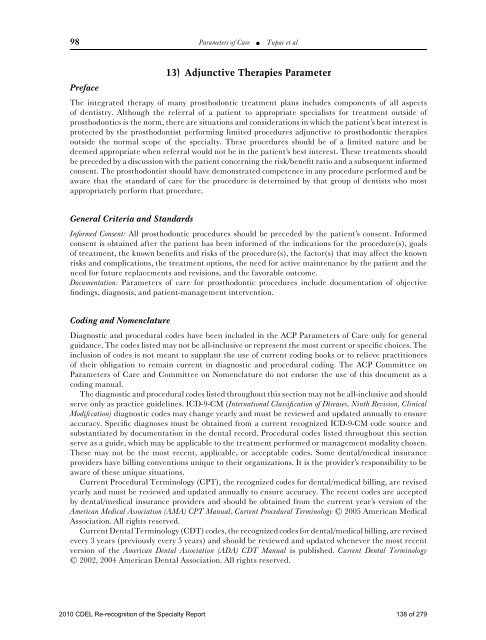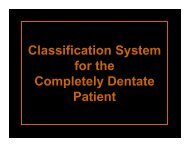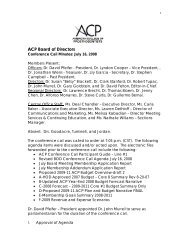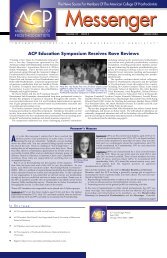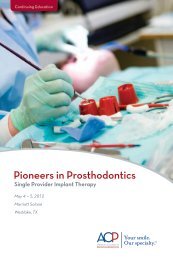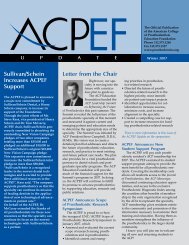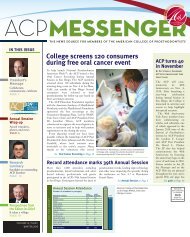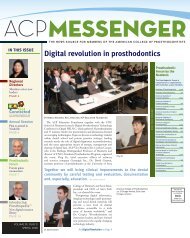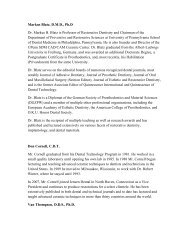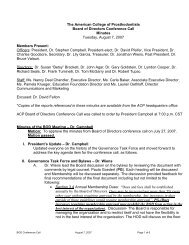PROSTHODONTICS - American College of Prosthodontists
PROSTHODONTICS - American College of Prosthodontists
PROSTHODONTICS - American College of Prosthodontists
Create successful ePaper yourself
Turn your PDF publications into a flip-book with our unique Google optimized e-Paper software.
98 Parameters <strong>of</strong> Care Tupac et alPreface13) Adjunctive Therapies ParameterThe integrated therapy <strong>of</strong> many prosthodontic treatment plans includes components <strong>of</strong> all aspects<strong>of</strong> dentistry. Although the referral <strong>of</strong> a patient to appropriate specialists for treatment outside <strong>of</strong>prosthodontics is the norm, there are situations and considerations in which the patient’s best interest isprotected by the prosthodontist performing limited procedures adjunctive to prosthodontic therapiesoutside the normal scope <strong>of</strong> the specialty. These procedures should be <strong>of</strong> a limited nature and bedeemed appropriate when referral would not be in the patient’s best interest. These treatments shouldbe preceded by a discussion with the patient concerning the risk/benefit ratio and a subsequent informedconsent. The prosthodontist should have demonstrated competence in any procedure performed and beaware that the standard <strong>of</strong> care for the procedure is determined by that group <strong>of</strong> dentists who mostappropriately perform that procedure.General Criteria and StandardsInformed Consent: All prosthodontic procedures should be preceded by the patient’s consent. Informedconsent is obtained after the patient has been informed <strong>of</strong> the indications for the procedure(s), goals<strong>of</strong> treatment, the known benefits and risks <strong>of</strong> the procedure(s), the factor(s) that may affect the knownrisks and complications, the treatment options, the need for active maintenance by the patient and theneed for future replacements and revisions, and the favorable outcome.Documentation: Parameters <strong>of</strong> care for prosthodontic procedures include documentation <strong>of</strong> objectivefindings, diagnosis, and patient-management intervention.Coding and NomenclatureDiagnostic and procedural codes have been included in the ACP Parameters <strong>of</strong> Care only for generalguidance. The codes listed may not be all-inclusive or represent the most current or specific choices. Theinclusion <strong>of</strong> codes is not meant to supplant the use <strong>of</strong> current coding books or to relieve practitioners<strong>of</strong> their obligation to remain current in diagnostic and procedural coding. The ACP Committee onParameters <strong>of</strong> Care and Committee on Nomenclature do not endorse the use <strong>of</strong> this document as acoding manual.The diagnostic and procedural codes listed throughout this section may not be all-inclusive and shouldserve only as practice guidelines. ICD-9-CM (International Classification <strong>of</strong> Diseases, Ninth Revision, ClinicalModification) diagnostic codes may change yearly and must be reviewed and updated annually to ensureaccuracy. Specific diagnoses must be obtained from a current recognized ICD-9-CM code source andsubstantiated by documentation in the dental record. Procedural codes listed throughout this sectionserve as a guide, which may be applicable to the treatment performed or management modality chosen.These may not be the most recent, applicable, or acceptable codes. Some dental/medical insuranceproviders have billing conventions unique to their organizations. It is the provider’s responsibility to beaware <strong>of</strong> these unique situations.Current Procedural Terminology (CPT), the recognized codes for dental/medical billing, are revisedyearly and must be reviewed and updated annually to ensure accuracy. The recent codes are acceptedby dental/medical insurance providers and should be obtained from the current year’s version <strong>of</strong> the<strong>American</strong> Medical Association (AMA) CPT Manual. Current Procedural Terminology C○ 2005 <strong>American</strong> MedicalAssociation. All rights reserved.Current Dental Terminology (CDT) codes, the recognized codes for dental/medical billing, are revisedevery 3 years (previously every 5 years) and should be reviewed and updated whenever the most recentversion <strong>of</strong> the <strong>American</strong> Dental Association (ADA) CDT Manual is published. Current Dental TerminologyC○ 2002, 2004 <strong>American</strong> Dental Association. All rights reserved.2010 CDEL Re-recognition <strong>of</strong> the Specialty Report 138 <strong>of</strong> 279


